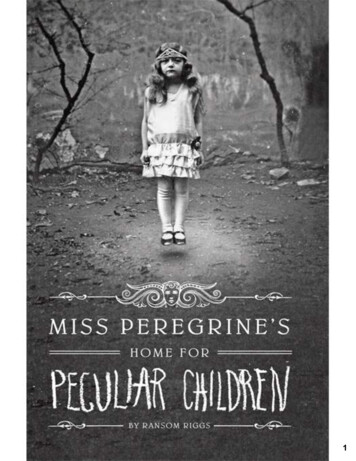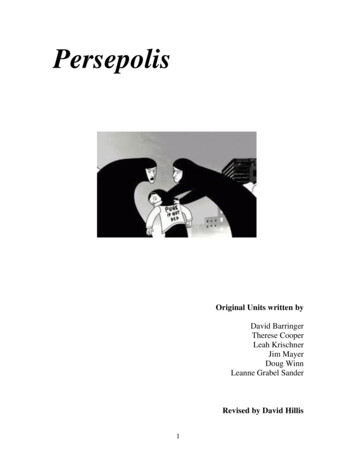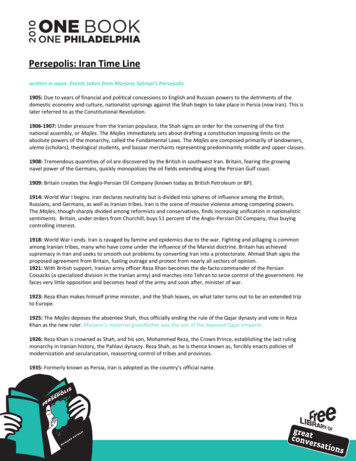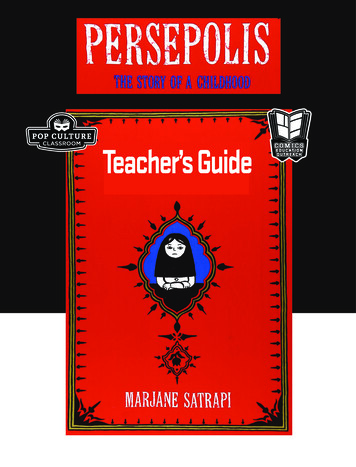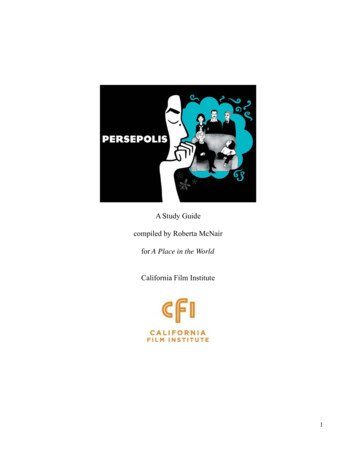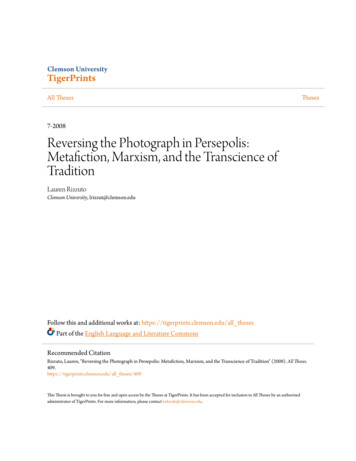
Transcription
Clemson UniversityTigerPrintsAll ThesesTheses7-2008Reversing the Photograph in Persepolis:Metafiction, Marxism, and the Transcience ofTraditionLauren RizzutoClemson University, lrizzut@clemson.eduFollow this and additional works at: https://tigerprints.clemson.edu/all thesesPart of the English Language and Literature CommonsRecommended CitationRizzuto, Lauren, "Reversing the Photograph in Persepolis: Metafiction, Marxism, and the Transcience of Tradition" (2008). All Theses.409.https://tigerprints.clemson.edu/all theses/409This Thesis is brought to you for free and open access by the Theses at TigerPrints. It has been accepted for inclusion in All Theses by an authorizedadministrator of TigerPrints. For more information, please contact kokeefe@clemson.edu.
REVERSING THE PHOTOGRAPH IN PERSEPOLIS:METAFICTION, MARXISM, AND THE TRANSCIENCE OF TRADITIONA ThesisPresented tothe Graduate School ofClemson UniversityIn Partial Fulfillmentof the Requirements for the DegreeMaster of ArtsEnglishbyLauren E. RizzutoAugust 2008Accepted by:Dr. Michelle Martin, Committee ChairDr. Cameron BushnellDr. Susanna Ashton
ABSTRACTMarjane Satrapi’s autobiographical Persepolis: The Story of a Childhood andPersepolis 2: The Story of a Return together illustrate the growth of an Iranian girlbefore, during, and after the Islamic Revolution; unlike other historical memoirs,however, Satrapi’s books are written entirely in comic strips. Because the authorprivileges the text-and-image delivery of comics, a genre usually targeted towardadolescents, rather than the ostensibly objective nature of the history book to conveyboth her family’s and her nation’s history, Persepolis does not only refute the authorityof a Westernized historical record but also challenges the traditional ways in which welearn history. As an author and an artist, Satrapi bridges generational, cultural, andhistorical barriers to tell a story that secures the graphic novel’s place as a genre worthyof literary scholarship, redefines history, and constructs the riveting coming-of-age of aMarxist, marginalized individual engaged with her own, internal revolution.ii
ACKNOWLEDGMENTSAbove all others, I would like to thank Dr. Michelle Martin for chairing my thesis,but more specifically for her constant encouragement, constructive criticism, children’sliterature and coffee get-togethers, chicken noodle soup, and warm welcome intoacademia; her tireless support has been invaluable to my graduate school experience. Iwould also like to express my sincere appreciation to Dr. Cameron Bushnell for herinsightful comments, enthusiasm, and guidance in revision, and to Dr. Susanna Ashton,who readily committed to my project despite having more pressing obligations. Finally, Iwould like to thank the following people for reasons best known to them: my parents,Geoffrey Wyss, Alma Bennett, and my fellow graduate students—especially MatthewFairman, Russell Hehn, and of course Natalie Couch, who is both a treasured friend andcolleague.iii
TABLE OF CONTENTSPageTITLE PAGE .iABSTRACT.iiACKNOWLEDGMENTS .iiiLIST OF FIGURES. vCHAPTERI.A History in Pictures: Getting Graphic with Persepolis . 1II.“So you don’t see me”: Reversing the Photograph . 18III.Commie Comics: Marxism and the Anti-Bildungsroman.36WORKS CITED .63iv
LIST OF FIGURESFigurePage1.1Cover of Persepolis, first volume .61.2The Veil . 71.3The Key . 101.4Burning theatre. 121.5The street bombing . 142.1Class photo. 182.2Eby the photographer . 272.3Dark humor.282.4Taji’s protest . 313.1No identity .393.2Marji divided.423.3A revolutionary anarchists’ party. 553.4Marji behind bars. 59v
CHAPTER 1A History in Pictures: Getting Graphic with PersepolisMarjane Satrapi’s two-volume work Persepolis is the autobiography, written as agraphic novel, of an Iranian girl growing up against the backdrop of the IslamicRevolution. Graphic novels belong to the “comix,” or comics, genre because they derivatefrom comic strips, and authors of graphic novels will often refer to their works as comics.Critics and authors alike have applied the term “graphic novel” to these comic books forseveral very different reasons: their presentation usually resembles cartoons, or comics;they are longer in length than the typical comic book (both Persepolis books are over 100pages); and they delve into supposedly more literarily credible subjects, such as history.These varied justifications become problematic, however, when we consider onesignificant question these qualifications raise: in regards to the graphic novel’s placewithin literary scholarship, what is more important, content or form? For example, priorto Art Spiegelman’s Maus, which is an autobiographical and biographical Holocaustnarrative in graphic novel format, comics were not really considered a genre capable ofserious literary work; even now, many readers would disregard the heavy subject matterof the Persepolis books and instead would argue that they lack historical authenticitybecause they are written in cartoons. Furthermore, in a Western society whose popculture is incessantly becoming more visual, literary critics hesitate to defend graphicnovels’ scholarly substance because they, unlike other “serious” text-dependentliterature, are largely visual constructions. Thus, even though Persepolis offersunprecedented insight into the lives of marginalized Iranians during the IslamicRevolution, both scholars and readers may snub Satrapi’s work simply because it belongsto the comics genre.
And yet there is no doubt that both Persepolis: The Story of a Childhood and itssequel Persepolis 2: The Story of a Return tell a serious story; the books examine abreadth of topics, including war, transcultural identity, Marxism, a selective tradition ofhistory, and gender expectations. Thus, in addition to comics, critics tout Satrapi’snovels as belonging to many genres, including YA fiction, autobiographical (and in someparts, biographical) memoir, Bildungsroman, and history book. Their variousclassifications complicate the very notion of “genre” itself; for example, two of thesedistinctions—memoir and history book—concern truth, or at least our perception of it,but the criteria for each differs considerably. Since we assume that the memoir reliesupon the subjective recollection of the narrator, we have less difficulty privilegingindividual experience over acknowledged events. This is not the case with the historybook, a document containing agreed-upon facts and dates; though we may admit thathistory is more often written by those in power, we still largely attribute the historybook’s credibility to its objectivity. Therefore, though readers may search for truth inboth, blurring the lines may result in doubt about the work’s credibility in either form;because the two-volume1 Persepolis story is simultaneously memoir and history book, itrisks being neither—an additional obstacle for Satrapi to confront since mainstreamreaders have not exactly embraced the graphic novel as a form of worthy literature.In 1992, Art Spiegelman’s graphic novel Maus won a special Pulitzer Prize for itsportrayal of the Holocaust in cat-and-mouse form, and ever since, the comics-inspiredgenre has experienced an ongoing transitional status from pop cultural product toserious literary work. I find a similar classification dilemma in the Persepolis books,1Although Persepolis was published in two volumes when it was published in the United States,its original publication in France included four segments. Since I have used the United Statespublications in my study, however, my parenthetical citations will indicate either “Persepolis” or“Return.”2
which attempt to convey the antecedent and aftermath of a less-examined holocaust, theIslamic Revolution. Whereas the devastating effects of World War II and Nazism havelong penetrated Children’s and Adolescent Literature, Satrapi’s book remains singular inits subject matter: very few books exist for youthful audiences that portray thecontemporary Middle East, and the Persepolis books are the first to feature a female,feminist, Iranian protagonist in graphic novels. Thus, because Satrapi’s work, likeSpiegelman’s, illuminates a most traumatic chunk of history in a genre that, according tomany critics, retains the “shallow” feel of comic books, my thesis will essentially addresswhy Satrapi chose to write her nation’s story in a graphic novel, how her choice hasimpacted both comix and adolescent literature, and most significantly, the Persepolisbooks’ ability to change the ways we traditionally understand history.The overarching purpose of my study is not, then, merely to discern betweenfiction and truth in the Persepolis novels’ account of Iranian history; rather, I am morespecifically interested in the ways Satrapi chooses to write history. Because Persepolisand Return are written in comic strips, readers consequently receive historicalinformation in a combination of text and pictures. Unlike other historical accounts,however, Satrapi’s work does not seek to tell its story from an objective viewpoint; it isthe autobiography of Marjane Satrapi, told through the eyes of Marji, her cartoonchildhood self. More importantly, it is the story of a marginalized individual: Marjibegins her story not only as a child but also a female child with radical political beliefs forthe time and for her age. From the first few pages, readers understand that Marji is notexactly a traditional Iranian girl, and her Marxist family is “very modern and avantgarde” (Satrapi, Persepolis 6), which contrasts significantly with the common Westernperception of Islamic fundamentalism. And if that were not enough to heap onto the pile3
of building skepticism, Satrapi uses ironic humor throughout both books whiledescribing the horrifying effects of the Islamic Revolution.Like Satrapi herself, the Persepolis books emerge as hybrid, and arguablymarginal, constructions. The set comes to the United States as a transcultural text—firstwritten in French by an Iranian who publishes her work for a French audience, and thentranslated into English—in the unconventional, text-and-image format of the graphicnovel. Additionally, its atypical protagonist gives rise to questions of narrator reliabilityand historical accuracy. Satrapi anticipates some objections to her work, as she writes inthe introduction to the first volume:[T]his old and great civilization has been discussed mostly in connectionwith fundamentalism, fanaticism, and terrorism. As an Iranian who haslived more than half of my life in Iran, I know that this image is far fromthe truth. This is why writing Persepolis was so important to me. Ibelieve that an entire nation should not be judged by the wrongdoings of afew extremists. (introduction, n.pag.)From a critic’s perspective, it seems that Persepolis and Return urge a post-colonialreading of our preconceptions regarding the Middle East: the texts resist a Western, andarguably imperial, viewpoint by interrogating our Western ideas of an “official,”unbiased version of history; simply put, by writing her history in a graphic novel, Satrapirefutes the absolute authority of any historical record while simultaneously challengingthe traditional ways (such as history books and photographs) we learn history. Still, onemay question Satrapi’s choice of using the graphic novel to portray her own history,especially considering its somewhat ephemeral status as a recently-taken-seriouslyproduct of pop culture. Scholars Hugo Frey and Benjamin Noys, for instance, suggest4
that authors using the term “graphic novel” are merely “attempt[ing] to rescue comicsfrom their critical neglect,” a neglect largely stemming from comics’ hybrid, crosscultural construction of both text and image (255). What Frey and Noys are implying,then, is that the genre is still considered a controversial format for works of literary andcultural importance, even by comics’ creators. For Satrapi, the value most obviously atstake is the preserved integrity of the Iranian people, but the use of a graphic novel mayweaken her argument’s credibility.Oddly enough, I think that it is precisely Satrapi’s utilizati
This Thesis is brought to you for free and open access by the Theses at TigerPrints. It has been accepted for inclusion in All Theses by an authorized administrator of TigerPrints. For more information, please contactkokeefe@clemson.edu. Recommended Citation Rizzuto, Lauren, "Reversing the Photograph in Persepolis: Metafiction, Marxism, and the Transcience of Tradition" (2008).All Theses.

